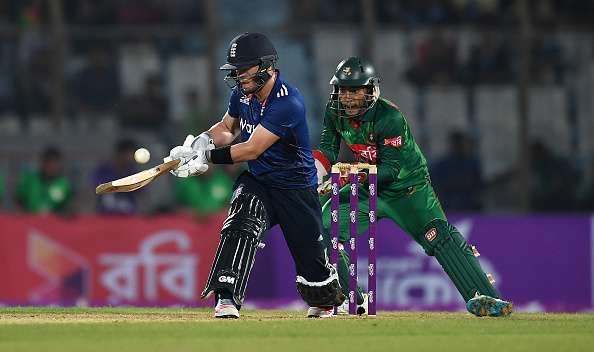
England were smarter and more composed than Bangladesh in the third ODI

Whether the match would proceed or not was the subject of discussion before the start of the third One-day international match between Bangladesh and England in Chittagong. The city experienced heavy rain for a couple of days and thus inclement weather was about to play spoilsport with the series locked at 1-1. There was a reserve day, but
Thankfully, the rain stopped, but the gloomy skies persisted and as soon as the captains of the two teams went out for the toss, they were greeted with loud cheers. There will be a battle between bat and ball and the Bangladesh cricket fans will have a great holiday to relish.
Despite the heavy downpour for the last couple of days, the track at Chittagong didn’t lose its actual nature. The track had bounce and a nice carry. It was one of those tracks which provided assistance for both the batsmen and bowlers. A batsman needs to get on top of the bounce and play the ball late with a straight bat rather than trying something adventurous. And a fielding team needs to stop the leakage of easy singles and twos and make the batsman play forward more rather than getting excited by the bounce of the wicket.
Buttler makes the right call
Jos Buttler read the track right and invited Bangladesh to bat first considering the gloomy skies and bounce of the pitch and he knew, with the progress of time, this track will settle down more and the bounce will be helpful to bat as the English batsmen are well accustomed to such.
Tamim Iqbal and Imrul Kayes’ start was steady but not an ideal one, as because on this track, one needs to utilise the bounce as much as possible to essay a rollicking start. But Tamim and Kayes decided to proceed in a more traditional manner – occupy the crease, see off the new ball and build a solid foundation which was quite an unspectacular idea.
It only helped Buttler to use his cricketing brain smartly. Butler knew he had bored Tamim and Kayes who are stroke makers and at any moment, they would try to come out of the shell and start hitting the ball in the air rather than keeping it on the ground.
Buttler set a fielder at short leg and Ben Stokes delivered a cross-seamed ball at which Kayes flicked the ball without even releasing about his balance and bat position and thus, walked to the pavilion.
But Tamim flexed his arms and along with Shabbir Rahman cracked pugnacious strokes to lift the run rate. The English think tank in the field wanted just that. Whenever Tamim gets going, he doesn’t mix caution with aggression, but keeps on playing his shots.
Butler introduced Adil Rashid and perhaps, he was advised to ball some loose deliveries to set up Tamim. Rashid dished out a loose ball outside off and Tamim failed to adjust his shot and tamely slapped it to cover while trying to play it on the onside.
Rashid then delivered another loose ball to Mahmudullah Riyad – a juicy long hop at which Mahmudullah tried to play it on the offside – a wrong ploy against long hops and thus, was dismissed cheaply. It was a poor shot against a poor delivery, but it was well-planned one as Butler knew, Bangladeshi batsmen love to do something silly against loose deliveries and Rashid’s plan to deliver such balls didn’t go waste.
Shabbir Rahman and Mushfiqur Rahim got accustomed to the bounce very well added 54 runs for the fourth wicket in a very short period of time.
England needed to strike gold and Rashid provided them the breakthrough and when he outsmarted Shakib Al Hasan, Bangladesh innings was stagnated by some smart thinking by the English captain and Adil Rashid.
Since Shakib’s dismissal, Bangladesh added 93 more runs in the last 15 overs. Mushfiqur Rahim rediscovered his touch, but on this track, they were 30 to 40 runs short.
Sharpness on the field helps England

England were very sharp-witted on the field – they set the Bangladeshi batsmen up, dried up the runs in the last 10 to 15 overs and scripted breakthroughs in the crucial stages of the game whenever Bangladesh tried to gain the momentum.
While chasing, England’s batting was all about composure rather than the rush of blood. They cracked boundaries but they concentrated more on maneuvering the strike which never let them feel the pressure of the asking run rate.
Ben Duckett showed why is he rated so highly by the English critics. He applied himself superbly at the crease and his manner of stroke-play indicates, he is well set to become one of the finest in Test cricket. Especially his authority over the sweep shot was brilliant. He notched up 28 runs from ten sweep shots – conventional and reverse – and this helped him to neutralize the Bangladeshi spinners to a great extent.
Even when a partnership was broken, England never got panicked but maintained their composure to steer the ship safely to shore. Even in the end overs, when Bangladesh would have started to deal in boundaries, they didn’t bother to block and rotate the strike more and went for the big shots after two or more singles and couples were taken.
This was nothing but sheer professionalism and smart batting.
The Bangladeshi spinners failed to make an impact as because they thought, this track would turn and looked for turn off the pitch rather than bowling wicket-to-wicket and making the batsmen drive forward. Meanwhile, the fielding was ordinary and failed to stop the leakage of easy singles and twos.
Mashrafe Bin Mortaza came back strongly with the ball and tried to make the weather heavy, but England were in no mood to surrender cheaply as they were determined, smart and more composed than the home team.